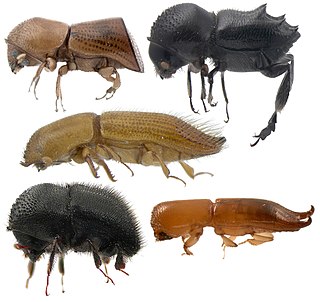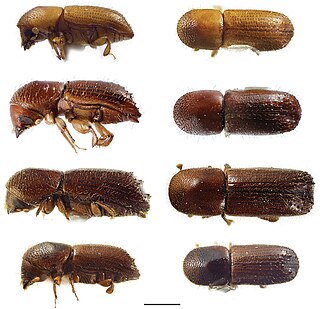Related Research Articles

Xyleborini are a tribe of ambrosia beetles, highly specialized weevils of the subfamily Scolytinae. Much of the ambrosia beetle fauna in Eurasia and the Americas consists of Xyleborini species. Some Xyleborini are notorious invasive species.

Xyleborus affinis, the sugarcane shot-hole borer, is a species of ambrosia beetle in the family Curculionidae. It is found on all continents with woodlands and is one of the most widespread ambrosia beetles internationally, primarily in areas with humid tropical climates like Florida. Like other ambrosia beetles, Xyleborus affinis is attracted to dead fallen logs in early stages of decay. Due to the presence of X. affinis on moist timber, this species is mistakenly believed to be the cause of tree death. However, there is insufficient evidence to support their presence as a causal factor. Rather, these beetles are believed to target and accelerate the decay process of trees that are already deteriorated and weak.
Ambrosiodmus asperatus, commonly known as ambrosia beetle, is a species of weevil found in China, India, Nepal, Indonesia: Java, Sumatra, Japan: Ryukyu Islands, Malaysia, Sri Lanka, Taiwan, and Brunei. The species also introduced to Australia.
Cryphalogenes euphorbiae, is a species of weevil found in Sri Lanka.
Cryphalogenes is a genus of weevils belonging to the family Hydrophilidae endemic to the island of Sri Lanka.
Euwallacea piceus, is a species of weevil native to Oriental Asia but introduced to African and other Westerns Pacific parts of the world. It is a serious pest in tropical and subtropical parts of the Americas.
Sueus niisimai is a species of weevil found in India, Sri Lanka, China, Japan, Taiwan, Korea, Malaysia and Indonesia. It is also found in Australia and Fiji, presumably introduced.
Xyleborinus andrewesi, is a species of weevil widely distributed throughout the Old World tropics and introduced to many New World countries.
Xyleborinus exiguus, is a species of weevil widely distributed throughout the Old World tropics and introduced to African and South American countries.
Xylosandrus arquatus, is a species of weevil endemic to Sri Lanka.
Debus emarginatus, is a species of weevil widely distributed throughout the Old World tropics.
Xylosandrus discolor, is a species of weevil found in Australia, Micronesia, Myanmar, China, India, Sri Lanka, Indonesia, Malaysia, Taiwan and Thailand.
Xylosandrus mancus, is a species of weevil found in Afrotropical and Oriental regions.

Xylosandrus morigerus, is a species of weevil widespread throughout Afrotropical, Australian, Neotropical, Oceania and Oriental regions. It is also introduced to Palearctic regional countries.
Xylosandrus pygmaeus, is a species of weevil found in Indonesia, Malaysia and Sri Lanka.
Cnestus gravidus is a species of weevil found in Bangladesh, Sri Lanka, India, Myanmar, Laos, Thailand, Vietnam and China.
Arixyleborus mediosectus, is a species of weevil found in India, Sri Lanka, Cambodia, Myanmar, Philippines, Malaysia, Indonesia: Sumatra and Vietnam.
Arixyleborus rugosipes, is a species of weevil native to India, Sri Lanka, Philippines, Malaysia, Borneo, Vietnam, Indonesia, and in Australia, Japan, Korea, New Zealand as an exotic species.
Diuncus haberkorni, is a species of weevil found in India, Sri Lanka, Bangladesh, Taiwan, Java, Japan, Malaysia, New Guinea, South Korea, Taiwan, Thailand, and Vietnam. It is also imported to African countried such as South Africa, and Tanzania.
Euwallacea similis, is a species of weevil native in the Oriental region through to Australia but shows a cosmopolitan distribution due to introduction to many parts of the world.
References
- ↑ "Taxonomic changes and new records of Japanese bark and ambrosia beetles (Coleoptera, Curculionidae, Scolytinae)". researchgate.net. Retrieved 2021-09-05.
- ↑ "Arixyleborus malayensis (Schedl)". www.gbif.org. Retrieved 2021-09-06.
- ↑ "INDIAN SPECIES OF THE GENUS ARIXYLEBORUS HOPKINS ( seOL YTIDAE : COLEOPTERA)" (PDF). Bull. zool. Surv. India, 8 (1-3): 1-12, 1987. Retrieved 2021-09-05.
- ↑ "SE Asian Ambrosia Beetle ID: Fact sheet". idtools.org. Retrieved 2021-09-06.
- ↑ Beaver, R. A.; Sittichaya, W.; Liu, L-Y. (2014-10-21). "Arixyleborus malayensis" . Retrieved 2021-09-06.
- ↑ "Arixyleborus malayensis: Xyleborini Ambrosia Beetles". xyleborini.myspecies.info. Retrieved 2021-09-06.
- ↑ Cassis, G.; Reid, C.; Symonds, C.; Hela, F.; Sar, S. (2017). "Life history, identity and damage assessment of galip weevil". Bulletin ACIAR Final Reports. Canberra, Australia: Australian Centre for International Agricultural Research (ACIAR).
- ↑ Kew Science. "Canarium commune L." Plants of the World Online. Royal Botanic Gardens, Kew. Retrieved 27 January 2022.
- ↑ Kew Science. "Canarium indicum L." Plants of the World Online. Royal Botanic Gardens, Kew. Retrieved 27 January 2022.
- ↑ "HISL - PEET Scolytinae". xyleborini.speciesfile.org. Retrieved 2021-09-06.